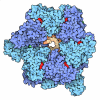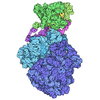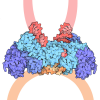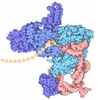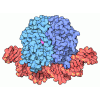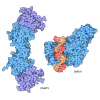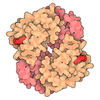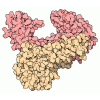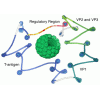[English] 日本語
 Yorodumi
Yorodumi- PDB-9eoz: Human OGG1 bound to a nucleosome core particle with 8-oxodGuo les... -
+ Open data
Open data
- Basic information
Basic information
| Entry | Database: PDB / ID: 9eoz | ||||||||||||||||||
|---|---|---|---|---|---|---|---|---|---|---|---|---|---|---|---|---|---|---|---|
| Title | Human OGG1 bound to a nucleosome core particle with 8-oxodGuo lesion at SHL6.0 | ||||||||||||||||||
 Components Components |
| ||||||||||||||||||
 Keywords Keywords | DNA BINDING PROTEIN / hOGG1 / 8-oxoguanine / nucleosome / base excision repair | ||||||||||||||||||
| Function / homology |  Function and homology information Function and homology informationDefective OGG1 Substrate Binding / Defective OGG1 Substrate Processing / Defective OGG1 Localization / depurination / negative regulation of double-strand break repair via single-strand annealing / oxidized purine nucleobase lesion DNA N-glycosylase activity / base-excision repair, AP site formation / negative regulation of chromosome condensation / depyrimidination / Barr body ...Defective OGG1 Substrate Binding / Defective OGG1 Substrate Processing / Defective OGG1 Localization / depurination / negative regulation of double-strand break repair via single-strand annealing / oxidized purine nucleobase lesion DNA N-glycosylase activity / base-excision repair, AP site formation / negative regulation of chromosome condensation / depyrimidination / Barr body / : / 8-oxo-7,8-dihydroguanine DNA N-glycosylase activity / Displacement of DNA glycosylase by APEX1 / positive regulation of gene expression via chromosomal CpG island demethylation / pericentric heterochromatin formation / inner kinetochore / muscle cell differentiation / oocyte maturation / oxidized purine DNA binding / Hydrolases; Glycosylases; Hydrolysing N-glycosyl compounds / nucleosomal DNA binding / APEX1-Independent Resolution of AP Sites via the Single Nucleotide Replacement Pathway / nucleus organization / spermatid development / single fertilization / subtelomeric heterochromatin formation / RNA polymerase II core promoter sequence-specific DNA binding / negative regulation of megakaryocyte differentiation / protein localization to CENP-A containing chromatin / Replacement of protamines by nucleosomes in the male pronucleus / CENP-A containing nucleosome / Packaging Of Telomere Ends / Recognition and association of DNA glycosylase with site containing an affected purine / Cleavage of the damaged purine / embryo implantation / class I DNA-(apurinic or apyrimidinic site) endonuclease activity / DNA-(apurinic or apyrimidinic site) lyase / Deposition of new CENPA-containing nucleosomes at the centromere / Recognition and association of DNA glycosylase with site containing an affected pyrimidine / Cleavage of the damaged pyrimidine / telomere organization / RNA Polymerase I Promoter Opening / Inhibition of DNA recombination at telomere / Meiotic synapsis / Assembly of the ORC complex at the origin of replication / SUMOylation of chromatin organization proteins / Regulation of endogenous retroelements by the Human Silencing Hub (HUSH) complex / DNA methylation / Condensation of Prophase Chromosomes / Chromatin modifications during the maternal to zygotic transition (MZT) / SIRT1 negatively regulates rRNA expression / HCMV Late Events / innate immune response in mucosa / ERCC6 (CSB) and EHMT2 (G9a) positively regulate rRNA expression / PRC2 methylates histones and DNA / cellular response to reactive oxygen species / Regulation of endogenous retroelements by KRAB-ZFP proteins / Defective pyroptosis / nucleotide-excision repair / HDACs deacetylate histones / Regulation of endogenous retroelements by Piwi-interacting RNAs (piRNAs) / Nonhomologous End-Joining (NHEJ) / RNA Polymerase I Promoter Escape / Transcriptional regulation by small RNAs / Formation of the beta-catenin:TCF transactivating complex / response to radiation / Activated PKN1 stimulates transcription of AR (androgen receptor) regulated genes KLK2 and KLK3 / RUNX1 regulates genes involved in megakaryocyte differentiation and platelet function / HDMs demethylate histones / base-excision repair / G2/M DNA damage checkpoint / NoRC negatively regulates rRNA expression / B-WICH complex positively regulates rRNA expression / DNA Damage/Telomere Stress Induced Senescence / PKMTs methylate histone lysines / Meiotic recombination / Pre-NOTCH Transcription and Translation / Metalloprotease DUBs / multicellular organism growth / male gonad development / RMTs methylate histone arginines / Activation of anterior HOX genes in hindbrain development during early embryogenesis / nuclear matrix / Transcriptional regulation of granulopoiesis / HCMV Early Events / antimicrobial humoral immune response mediated by antimicrobial peptide / osteoblast differentiation / structural constituent of chromatin / UCH proteinases / antibacterial humoral response / nucleosome / heterochromatin formation / nucleosome assembly / E3 ubiquitin ligases ubiquitinate target proteins / Recruitment and ATM-mediated phosphorylation of repair and signaling proteins at DNA double strand breaks / HATs acetylate histones / RUNX1 regulates transcription of genes involved in differentiation of HSCs / Factors involved in megakaryocyte development and platelet production / MLL4 and MLL3 complexes regulate expression of PPARG target genes in adipogenesis and hepatic steatosis / Processing of DNA double-strand break ends Similarity search - Function | ||||||||||||||||||
| Biological species |  Homo sapiens (human) Homo sapiens (human)synthetic construct (others) | ||||||||||||||||||
| Method | ELECTRON MICROSCOPY / single particle reconstruction / cryo EM / Resolution: 3.1 Å | ||||||||||||||||||
 Authors Authors | Ren, M. / Gut, F. / Fan, Y. / Hopfner, K.-P. / Zhou, C. | ||||||||||||||||||
| Funding support |  China, China,  Germany, 5items Germany, 5items
| ||||||||||||||||||
 Citation Citation |  Journal: Nat Commun / Year: 2024 Journal: Nat Commun / Year: 2024Title: Structural basis for human OGG1 processing 8-oxodGuo within nucleosome core particles. Authors: Mengtian Ren / Fabian Gut / Yilan Fan / Jingke Ma / Xiajing Shan / Aysenur Yikilmazsoy / Mariia Likhodeeva / Karl-Peter Hopfner / Chuanzheng Zhou /   Abstract: Base excision repair (BER) is initialized by DNA glycosylases, which recognize and flip damaged bases out of the DNA duplex into the enzymes active site, followed by cleavage of the glycosidic bond. ...Base excision repair (BER) is initialized by DNA glycosylases, which recognize and flip damaged bases out of the DNA duplex into the enzymes active site, followed by cleavage of the glycosidic bond. Recent studies have revealed that all types of DNA glycosylases repair base lesions less efficiently within nucleosomes, and their repair activity is highly depended on the lesion's location within the nucleosome. To reveal the underlying molecular mechanism of this phenomenon, we determine the 3.1 Å cryo-EM structure of human 8-oxoguanine-DNA glycosylase 1 (hOGG1) bound to a nucleosome core particle (NCP) containing a common oxidative base lesion, 8-oxo-7,8-dihydro-2'-deoxyguanosine (8-oxodGuo). Our structural analysis shows that hOGG1 can recognize and flip 8-oxodGuo even within NCPs; however, the interaction between 8-oxodGuo and hOGG1 in a NCP context is weaker than in free DNA due to competition for nucleosomal DNA by the histones. Binding of OGG1 and the flipping of 8-oxodGuo by hOGG1 leads to a partial detachment of DNA from the histone core and a ratchet-like inward movement of nucleosomal DNA. Our findings provide insights into how the dynamic structure of nucleosomes modulate the activity of repair enzymes within chromatin. | ||||||||||||||||||
| History |
|
- Structure visualization
Structure visualization
| Structure viewer | Molecule:  Molmil Molmil Jmol/JSmol Jmol/JSmol |
|---|
- Downloads & links
Downloads & links
- Download
Download
| PDBx/mmCIF format |  9eoz.cif.gz 9eoz.cif.gz | 376.7 KB | Display |  PDBx/mmCIF format PDBx/mmCIF format |
|---|---|---|---|---|
| PDB format |  pdb9eoz.ent.gz pdb9eoz.ent.gz | 283.7 KB | Display |  PDB format PDB format |
| PDBx/mmJSON format |  9eoz.json.gz 9eoz.json.gz | Tree view |  PDBx/mmJSON format PDBx/mmJSON format | |
| Others |  Other downloads Other downloads |
-Validation report
| Summary document |  9eoz_validation.pdf.gz 9eoz_validation.pdf.gz | 1.2 MB | Display |  wwPDB validaton report wwPDB validaton report |
|---|---|---|---|---|
| Full document |  9eoz_full_validation.pdf.gz 9eoz_full_validation.pdf.gz | 1.2 MB | Display | |
| Data in XML |  9eoz_validation.xml.gz 9eoz_validation.xml.gz | 43 KB | Display | |
| Data in CIF |  9eoz_validation.cif.gz 9eoz_validation.cif.gz | 68 KB | Display | |
| Arichive directory |  https://data.pdbj.org/pub/pdb/validation_reports/eo/9eoz https://data.pdbj.org/pub/pdb/validation_reports/eo/9eoz ftp://data.pdbj.org/pub/pdb/validation_reports/eo/9eoz ftp://data.pdbj.org/pub/pdb/validation_reports/eo/9eoz | HTTPS FTP |
-Related structure data
| Related structure data |  19870MC M: map data used to model this data C: citing same article ( |
|---|---|
| Similar structure data | Similarity search - Function & homology  F&H Search F&H Search |
- Links
Links
- Assembly
Assembly
| Deposited unit | 
|
|---|---|
| 1 |
|
- Components
Components
-Protein , 5 types, 9 molecules ABFEKGLHM
| #1: Protein | Mass: 40092.289 Da / Num. of mol.: 1 Source method: isolated from a genetically manipulated source Source: (gene. exp.)  Homo sapiens (human) / Gene: OGG1, MMH, MUTM, OGH1 / Production host: Homo sapiens (human) / Gene: OGG1, MMH, MUTM, OGH1 / Production host:  References: UniProt: O15527, Hydrolases; Glycosylases; Hydrolysing N-glycosyl compounds, DNA-(apurinic or apyrimidinic site) lyase | ||||||
|---|---|---|---|---|---|---|---|
| #2: Protein | Mass: 11263.231 Da / Num. of mol.: 2 Source method: isolated from a genetically manipulated source Source: (gene. exp.)  Homo sapiens (human) Homo sapiens (human)Gene: HIST1H4A, H4/A, H4FA, HIST1H4B, H4/I, H4FI, HIST1H4C, H4/G, H4FG, HIST1H4D, H4/B, H4FB, HIST1H4E, H4/J, H4FJ, HIST1H4F, H4/C, H4FC, HIST1H4H, H4/H, H4FH, HIST1H4I, H4/M, H4FM, HIST1H4J, H4/E, ...Gene: HIST1H4A, H4/A, H4FA, HIST1H4B, H4/I, H4FI, HIST1H4C, H4/G, H4FG, HIST1H4D, H4/B, H4FB, HIST1H4E, H4/J, H4FJ, HIST1H4F, H4/C, H4FC, HIST1H4H, H4/H, H4FH, HIST1H4I, H4/M, H4FM, HIST1H4J, H4/E, H4FE, HIST1H4K, H4/D, H4FD, HIST1H4L, H4/K, H4FK, HIST2H4A, H4/N, H4F2, H4FN, HIST2H4, HIST2H4B, H4/O, H4FO, HIST4H4 Production host:  #3: Protein | Mass: 15229.787 Da / Num. of mol.: 2 Source method: isolated from a genetically manipulated source Source: (gene. exp.)  Homo sapiens (human) / Gene: H3-3A, H3.3A, H3F3, H3F3A, PP781, H3-3B, H3.3B, H3F3B / Production host: Homo sapiens (human) / Gene: H3-3A, H3.3A, H3F3, H3F3A, PP781, H3-3B, H3.3B, H3F3B / Production host:  #4: Protein | Mass: 14004.329 Da / Num. of mol.: 2 Source method: isolated from a genetically manipulated source Source: (gene. exp.)  Homo sapiens (human) / Gene: H2AC6, H2AFL, HIST1H2AC / Production host: Homo sapiens (human) / Gene: H2AC6, H2AFL, HIST1H2AC / Production host:  #5: Protein | Mass: 13806.018 Da / Num. of mol.: 2 Source method: isolated from a genetically manipulated source Source: (gene. exp.)  Homo sapiens (human) Homo sapiens (human)Gene: HIST1H2BC, H2BFL, HIST1H2BE, H2BFH, HIST1H2BF, H2BFG, HIST1H2BG, H2BFA, HIST1H2BI, H2BFK Production host:  |
-Widom 601 DNA (145- ... , 2 types, 2 molecules YZ
| #6: DNA chain | Mass: 44520.383 Da / Num. of mol.: 1 / Source method: obtained synthetically / Source: (synth.) synthetic construct (others) |
|---|---|
| #7: DNA chain | Mass: 45007.660 Da / Num. of mol.: 1 / Source method: obtained synthetically / Source: (synth.) synthetic construct (others) |
-Details
| Has ligand of interest | Y |
|---|---|
| Has protein modification | N |
-Experimental details
-Experiment
| Experiment | Method: ELECTRON MICROSCOPY |
|---|---|
| EM experiment | Aggregation state: PARTICLE / 3D reconstruction method: single particle reconstruction |
- Sample preparation
Sample preparation
| Component |
| ||||||||||||||||||||||||
|---|---|---|---|---|---|---|---|---|---|---|---|---|---|---|---|---|---|---|---|---|---|---|---|---|---|
| Source (natural) |
| ||||||||||||||||||||||||
| Source (recombinant) |
| ||||||||||||||||||||||||
| Buffer solution | pH: 7.5 | ||||||||||||||||||||||||
| Specimen | Embedding applied: NO / Shadowing applied: NO / Staining applied: NO / Vitrification applied: YES | ||||||||||||||||||||||||
| Vitrification | Cryogen name: ETHANE |
- Electron microscopy imaging
Electron microscopy imaging
| Experimental equipment |  Model: Titan Krios / Image courtesy: FEI Company |
|---|---|
| Microscopy | Model: FEI TITAN KRIOS |
| Electron gun | Electron source:  FIELD EMISSION GUN / Accelerating voltage: 300 kV / Illumination mode: FLOOD BEAM FIELD EMISSION GUN / Accelerating voltage: 300 kV / Illumination mode: FLOOD BEAM |
| Electron lens | Mode: BRIGHT FIELD / Nominal defocus max: 2900 nm / Nominal defocus min: 1100 nm |
| Image recording | Electron dose: 43.76 e/Å2 / Film or detector model: GATAN K2 SUMMIT (4k x 4k) |
- Processing
Processing
| EM software | Name: PHENIX / Version: 1.21.1_5286: / Category: model refinement | ||||||||||||||||||||||||
|---|---|---|---|---|---|---|---|---|---|---|---|---|---|---|---|---|---|---|---|---|---|---|---|---|---|
| CTF correction | Type: PHASE FLIPPING AND AMPLITUDE CORRECTION | ||||||||||||||||||||||||
| 3D reconstruction | Resolution: 3.1 Å / Resolution method: FSC 0.143 CUT-OFF / Num. of particles: 66370 / Symmetry type: POINT | ||||||||||||||||||||||||
| Refine LS restraints |
|
 Movie
Movie Controller
Controller


 PDBj
PDBj

